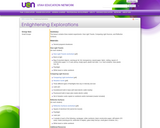
This lesson contains three student experiments: How Light Travels, Comparing Light Sources, and Reflective Surfaces.
- Subject:
- Fine Arts
- Material Type:
- Activity/Lab
- Lesson Plan
- Provider:
- Utah Education Network
- Date Added:
- 11/01/2017

This lesson contains three student experiments: How Light Travels, Comparing Light Sources, and Reflective Surfaces.
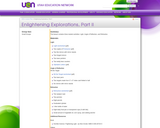
This lesson contains three student activities: Light, Angle of Reflection, and Refraction.
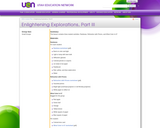
This lesson contains three student activities: Rainbows, Refraction with Prisms, and What Color Is It?
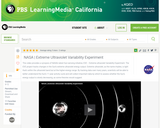
In this NASA video, scientists describe how the Extreme Ultraviolet Variability Experiment will sample and track the Sun's ultraviolet irradiance, providing a detailed time sequence of extreme ultraviolet output -- data that can provide advance warning for potentially disruptive energy bursts.
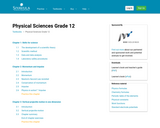
This is a comprehensive science textbook for Grade 12. You can download or read it on-line on your mobile phone, computer or iPad. Every chapter comes with video lessons and explanations which help bring the ideas and concepts to life. Summary presentations at the end of every chapter offer an overview of the content covered, with key points highlighted for easy revision. Topics covered are: organic molecules, organic chemistry, organic macromolecules, polymers, reaction rates, electrochemical reactions, the chemical industry, motion in two dimensions, mechanical properties of matter, work, energy and power, doppler effect, colour, 2D and 3D wavefronts, wave nature of matter, electrodynamics, electronics, electromagnetic radiation, optical phenomena and properties of matter, light, photoelectric effect, lasers. This book is based upon the original Free High School Science Text series.
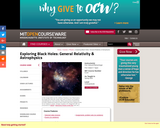
Study of physical effects in the vicinity of a black hole as the basis for understanding general relativity, astrophysics, and elements of cosmology. Extension to current developments in theory and observation. Energy and momentum in flat spacetime; the metric; curvature or spacetime near rotating and nonrotating centers of attraction; the Global Positioning System and its dependence on general relativity; trajectories and orbits of particles. Subject has online component and classroom lectures are replaced with online interactions: manipulation of visualization software, access to websites describing current research, electronic submission of homework, and structured online discussions between undergraduates and alumni and with instructors and graduate specialists in the topics covered.

In a hands-on way, students explore light's properties of absorption, reflection, transmission and refraction through various experimental stations within the classroom. To understand absorption, reflection and transmission, they shine flashlights on a number of preselected objects. To understand refraction, students create indoor rainbows. An understanding of the fundamental properties of light is essential to designing an invisible laser security system.
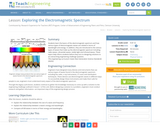
Students learn the basics of the electromagnetic spectrum and how various types of electromagnetic waves are related in terms of wavelength and energy. In addition, they are introduced to the various types of waves that make up the electromagnetic spectrum including, radio waves, ultraviolet waves, visible light and infrared waves. These topics help inform students before they turn to designing solutions to an overarching engineering challenge question.
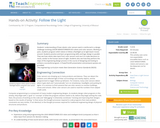
Students' understanding of how robotic light sensors work is reinforced in a design challenge involving LEGO MINDSTORMS(TM) NXT robots and light sensors. Working in pairs, students program LEGO robots to follow a flashlight as its light beam moves around. Students practice and learn programming skills and logic design in parallel. They see how robots take input from light sensors and use it to make decisions to move, similar to the human sense of sight. Students also see how they perform the steps of the engineering design process in the course of designing and testing to achieve a successful program. A PowerPoint® presentation and pre/post quizzes are provided.
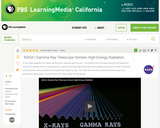
This video from NASA describes the GLAST satellite, which is equipped with a gamma-ray telescope, and shares some background about the kinds of extreme universal phenomena indicated by the presence of gamma rays.
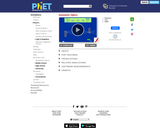
How does a lens form an image? See how light rays are refracted by a lens. Watch how the image changes when you adjust the focal length of the lens, move the object, move the lens, or move the screen.
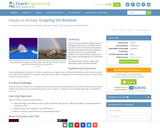
Students are introduced to different ways of displaying visual spectra, including colored "barcode" spectra, like those produced by a diffraction grating, and line plots displaying intensity versus color, or wavelength. Students learn that a diffraction grating acts like a prism, bending light into its component colors.
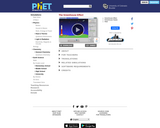
How do greenhouse gases affect the climate? Explore the atmosphere during the ice age and today. What happens when you add clouds? Change the greenhouse gas concentration and see how the temperature changes. Then compare to the effect of glass panes. Zoom in and see how light interacts with molecules. Do all atmospheric gases contribute to the greenhouse effect?
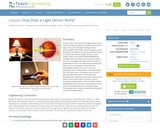
Students learn more about how light sensors work, reinforcing their similarities to the human sense of sight. They look at the light sensing process incoming light converted to electrical signals sent to the brain through the human eye anatomy as well as human-made electrical light sensors. A mini-activity, which uses LEGO MINDSTORMS(TM) NXT intelligent bricks and light sensors gives students a chance to investigate how light sensors function in preparation for the associated activity involving the light sensors and taskbots. A PowerPoint® presentation explains stimulus-to-response pathways, sensor fundamentals, and details about the LEGO light sensor, including its two modes of gathering data and what its numerical value readings mean. Students take pre/post quizzes and watch a short online video. This lesson and its associated activity enable students to gain a deeper understanding of how robots can take sensor input and use it to make decisions via programming.
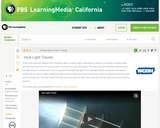
In this video segment adapted from Shedding Light on Science, observe demonstrations of the fundamental idea that light travels in straight lines.
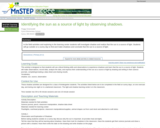
This activity is a kindergarten field and classroom investigation where students make observations, collect data and share conclusions that shows they understand that the sun is a source of light.
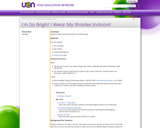
In this lesson students will use UV beads to observe and draw energy. Students will describe how light can be produced, reflected, refracted, and separated into visible light of various colors.
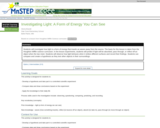
This is a short unit (including hands on activities) to expand our study of how light travels and how it behaves when it hits an object.

This activity is lab oriented where students will observe that light travels in a straight line and is reflected, redirected, absorbed, or passes through objects.
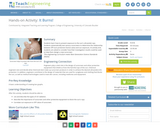
In this activity, students learn how to prevent exposure to the Sun's harmful ultraviolet rays. Students will systematically test various sunscreens to determine the relationship between spf (sun protection factor) value and sun exposure. At the end of the activity, students are asked to consider how this investigation could be used to help them design a new sunscreen.